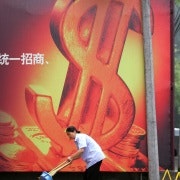Migrant workers driving China's consumer revolution
China’s transformation into the “workshop of the world” just over a decade ago was powered by rural migrant workers earning less than their counterparts at the start of the UK’s industrial revolution in the 18th century as they produced consumer goods for shopping malls worldwide. Now, in a reversal set to drive China’s next big economic evolution, an estimated 220 million migrant workers are becoming potent consumers in their own right.
This cohort spent 4.2 trillion yuan ($US677 billion) on consumer goods and services in 2012, according to a nationwide survey of 1,500 migrants by China Confidential, a Financial Times research service. Putting this into context, it is equivalent to 1.5 times total consumer spending in Indonesia last year and 23 per cent more than that of Turkey in 2011.
The shift is a metaphor for the country itself, deriving as much from psychological, social and generational shifts as economic inflection points. Migrants born into the relative plenty of the 1990s are considerably more spendthrift than those born in the 1980s and 1970s, spending 53 per cent of their incomes, compared with 47.2 per cent and 38.3 per cent respectively, the survey shows.
Much of their monthly discretionary spending goes on mass consumer items such as instant noodles, fast food, beer, soft drinks, clothing, footwear and mobile phones. While brand consciousness remains rudimentary, preferences for some brands – foreign and domestic – are rapidly emerging as the cohort climbs the income ladder. These include Uni-President and Master Kong noodles; KFC and McDonald’s for fast food; Nokia and Samsung for mobile phones; Anta and Li-Ning sportswear; Shuanghui for processed meat; Snow and Tsingtao for beer; and Taobao for online shopping.
Such early fumbles toward brand sophistication are remarkable in a group treated with almost universal condescension by city dwellers only a decade ago. Leslie Chang, author of Factory Girls , a book about the migrant phenomenon, describes how bosses – secure in the knowledge that there were numberless millions more would-be workers than jobs – would treat employees with ill-disguised disdain.
As Chang notes, many of the thousands of factories in Dongguan, a manufacturing hub in the southern province of Guangdong, had an Orwellian aura, with slogans on the walls such as: “To die poor is a sin”; “If you don’t work hard today, you’ll search hard for work tomorrow”; and “Through doing something, you will learn it”. Job advertisements were similarly brusque: “Sales specialist. Can eat bitterness and endure hardship. No only children.”
The tables have turned. Since blue-collar labour moved from surplus to shortage in 2010, bargaining power has shifted from bosses to migrants, obliging employers to learn some charm and lure workers with rising salaries and improved benefits. Throughout 2012, the proportion of blue-collar openings filled each month never exceeded 75 per cent, according to China Confidential data.
The result of this fundamental labour market reversal has been to propel migrant workers’ incomes sharply higher, a trend that is unlikely to change for as long as blue-collar labour remains in shortage. Indeed, such incomes are rising faster than those of any other significant consumer cohort – climbing 12 per cent to 2,995 yuan a month in 2012, the China Confidential survey shows. This compares with the average annual growth rate in urban incomes of 9.3 per cent of the past decade.
From Beijing’s perspective, the vitality of the migrant worker cohort could hardly be of greater importance to the twin aims of rebalancing the growth model and spurring urbanisation. In the first endeavour, there is no question that migrant worker spending is an increasingly potent driver away from an over-reliance on investment-led growth and towards more consumption. Consumer spending in the first quarter of this year accounted for 55 per cent of gross domestic product growth, raising expectations that 2013 may be the third consecutive year in which consumption contributes more than investment to GDP growth.
For urbanisation, too – which Li Keqiang, the premier, has said is set to become the greatest source of domestic demand in the coming decade – rural migrants are seen as crucial. Li has plans to reform the household registration (hukou) system – which classifies everyone as either rural or urban – turning migrants into urban citizens, which qualifies them for more generous welfare allocations. The planned surge in welfare awards, in turn, is expected to spur consumer spending.
While the exact methodologies for hukou reform are yet to be announced by Beijing, signs are that many migrants are keen to embrace a settled urban future. Of the 220 million who live and work in cities but have no urban hukou, 131 million are keen to become permanent urban residents, the survey shows. If this number – roughly equivalent to the population of Japan – do settle permanently in cities, it will not be their sweat so much as their spending power that shapes China’s destiny.
The writer is principal at www.ftchinaconfidential.com.
Copyright The Financial Times 2013.
















